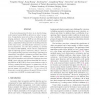Free Online Productivity Tools
i2Speak
i2Symbol
i2OCR
iTex2Img
iWeb2Print
iWeb2Shot
i2Type
iPdf2Split
iPdf2Merge
i2Bopomofo
i2Arabic
i2Style
i2Image
i2PDF
iLatex2Rtf
Sci2ools
CVPR
2008
IEEE
2008
IEEE
Enhanced biologically inspired model
It has been demonstrated by Serre et al. that the biologically inspired model (BIM) is effective for object recognition. It outperforms many state-of-the-art methods in challenging databases. However, BIM has the following three problems: a very heavy computational cost due to the dense input, a disputable pooling operation in modeling relations of the visual cortex, and blind feature selection in a feedforward framework. To solve these problems, we develop an enhanced BIM (EBIM), which removes uninformative input by imposing sparsity constraints, utilizes a novel local weighted pooling operation with stronger physiological motivations, and applies a feedback procedure that selects effective features for combination. Empirical studies on the CalTech5 database and CalTech101 database show that EBIM is more effective and efficient than BIM. We also apply EBIM to the MIT-CBCL street scene database to show it achieves comparable performance in comparison with the current best performance....
Computer Vision | CVPR 2008 | Disputable Pooling Operation | Enhanced Bim | Serre Et Al | Stronger Physiological Motivations | Weighted Pooling Operation |
| Added | 12 Oct 2009 |
| Updated | 12 Oct 2009 |
| Type | Conference |
| Year | 2008 |
| Where | CVPR |
| Authors | Yongzhen Huang, Kaiqi Huang, Liangsheng Wang, Dacheng Tao, Tieniu Tan, Xuelong Li |
Comments (0)

